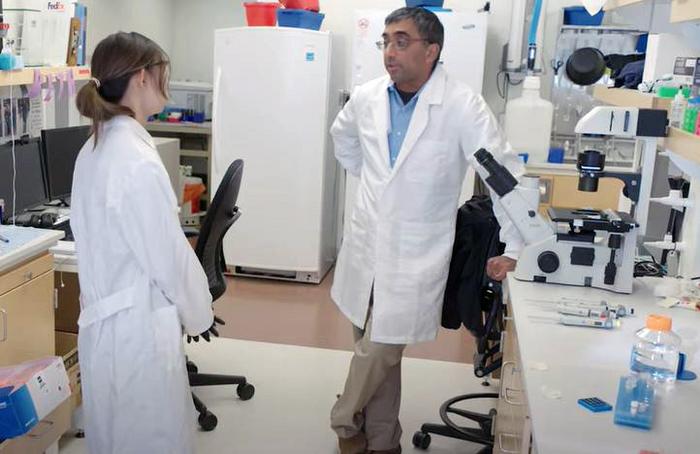Genomes can now be entrusted to store information about a variety of transient biological events inside of living cells, as they happen, like a flight recorder collecting data from an aircraft.

Credit: Randy Carnell/UW Medicine
Genomes can now be entrusted to store information about a variety of transient biological events inside of living cells, as they happen, like a flight recorder collecting data from an aircraft.
“Our method, which goes by the acronym ENGRAM, aims to turn cells into their own historians,” said Dr. Jay Shendure, a professor of genome sciences at the University of Washington School of Medicine and scientific director of the Brotman Baty Institute for Precision Medicine. Shendure led the effort, together with Wei Chen, a former graduate student, and Junhong Choi, a former postdoctoral fellow. Junhong Choi is now an assistant investigator at Memorial Sloan Kettering Cancer Center in New York.
ENGRAM stands for enhancer-driven genomic recording of transcriptional activity in multiplex. The acronym was inspired by a neuroscience term that refers to the physical basis for a memory.
A proof-of-concept report demonstrating some of the capabilities of ENGRAM is published today, July 17, in Nature.
“ENGRAM couples each kind of biological signal or event to a symbolic barcode. This approach offers a novel method for recording and complements previously developed molecular recording techniques.” said Wei Chen, who is now a postdoctoral fellow at the UW Medicine Institute for Protein Design.
This new strategy traces and archives the type and timing of biological signals by inserting this information into the genome. For example, this can include keeping tabs on the commands that turn genes on or off. Such recordings might hold clues to what occurs within stem cells to spur them into becoming different cell types. It might also offer insights into other questions about how cells operate, and how their past influences their future.
Shendure said that creating a biological record of cellular activities is an old idea. However, researchers had run into difficulties measuring more than a handful of signals in the same system, as well as in recording the order in which multiple signals occurred.
A few years ago, Choi, Shendure and their colleagues overcame some of these obstacles with a method called DNA Typewriter. With this system, researchers could write many symbols to DNA in an ordered fashion. However, the challenge remained of how to encode biological meaning to each symbol.
“DNA Typewriter is analogous to a keyboard with many symbols. With ENGRAM, we make those symbols specific to various biological signals of interest,” Shendure said.
In today’s Nature paper, Shendure and his team described how symbolic recording can follow the actions of non-coding DNA regions that control the protein production of neighboring genes. They also demonstrated how ENGRAM and DNA Typewriter can be combined. The scientists were able to record cell-type specific activities of dozens to hundreds of these sorts of gene-regulatory elements.
Some regions they tracked are part of gene regulatory networks behind several aspects of embryonic development. Other signals they traced mediate cell responses to stress, immune reactions to infection and cell survival.
They also applied ENGRAM to make daily recordings of mouse stem cells as they aggregated into embryonic organoids, a laboratory model of prenatal mouse development. ENGRAM might eventually help answer how, for example, a history of cell signaling events shaped the individual characteristics of a mouse embryo.
“As we were inspired by new advances in the CRISPR field for developing both the ENGRAM and DNA Typewriter systems, I imagine that these papers will inspire others to further improve genomic recording technologies – such that maybe one day we will record the entire history of cells,” said Junhong Choi.
The researchers developing ENGRAM say that work is still needed to realize what it and related genome-based recording technologies can potentially do.
“This is a strategy for capturing biological information in living systems. It is not specific to a particular field like cancer or neuroscience and hopefully will be useful across the board,” Shendure said.
Shendure noted the research covered in the paper played an important role in the development of the Seattle Hub for Synthetic Biology, a collaboration launched this past December among the Allen Institute, the Chan Zuckerberg Initiative, and the University of Washington. The project, of which Shendure serves as lead scientific director, is designing new technologies to record the history of cells over time.
The work reported today in Nature was supported by grants from the Paul G. Allen Frontiers Group, Alex’s Lemonade Stand Foundation, and the National Human Genome Research Institute (UM1HG011586, K99HG012973), as well as the Brotman Baty Institute for Precision Medicine. Shendure is an investigator of the Howard Hughes Medical Institute.
Journal
Nature
Method of Research
Experimental study
Subject of Research
Cells
Article Title
Symbolic recording of signaling and cis-regulatory element activity to DNA
Article Publication Date
17-Jul-2024
COI Statement
The University of Washington has filed a patent application partially based on this work, in which Junhong Choi, Wei Chen. and Jay Shendure are listed as inventors. Jay Shendureis on the scientific advisory board, a consultant or a cofounder of Adaptive Biotechnologies, Cajal Neuroscience, Camp4 Therapeutics, Guardant Health, Maze Therapeutics, Pacific Biosciences, Phase Genomics, Prime Medicine, Scale Biosciences, Somite Therapeutics and Sixth Street
Capital. The remaining authors declare no competing interests



